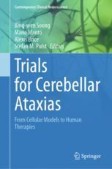Search
Search Results
-
Single-Session Cerebellar Transcranial Direct Current Stimulation Improves Postural Stability and Reduces Ataxia Symptoms in Spinocerebellar Ataxia
Spinocerebellar ataxia (SCA) results in balance and coordination impairment, and current treatments have limited efficacy. Recent evidence suggests...

-
Psychometric Validation of the Modified Functional Scale for the Assessment and Rating of Ataxia (f-SARA) in Patients With Spinocerebellar Ataxia
This study aimed to generate evidence to support psychometric validity of the modified functional Scale for the Assessment and Rating of Ataxia...

-
Spatiotemporal Gait Analysis of Patients with Spinocerebellar Ataxia Types 3 and 10 Using Inertial Measurement Units: A Comparative Study
Given the high morbidity related to the progression of gait deficits in spinocerebellar ataxias (SCA), there is a growing interest in identifying...

-
Factors Influencing Health-Related Quality of Life of Patients with Spinocerebellar Ataxia
BackgroundLittle is known about the progression of health-related quality of life (HRQoL) and predicting factors in spinocerebellar ataxia (SCA)....

-
Health-Related Quality of Life in Patients with Spinocerebellar Ataxia: a Validation Study of the EQ-5D-3L
Although health-related quality of life (HRQoL) has developed into a crucial outcome parameter in clinical research, evidence of the EQ-5D-3L...

-
Spinocerebellar ataxia type 11 (SCA11): TTBK2 variants, functions and associated disease mechanisms
Spinocerebellar ataxia type 11 (SCA11) is a rare type of autosomal dominant cerebellar ataxia, mainly characterized by progressive cerebellar ataxia,...

-
Association Between Serum Neurofilament Light Chain and Neurochemistry Deficits in Patients with Spinocerebellar Ataxia Type 3
Extensive evidence supports the claim that the serum neurofilament light chain (sNfL) can be used as a biomarker to monitor disease severity in...

-
Cognitive Decline and Mood Alterations in the Mouse Model of Spinocerebellar Ataxia Type 2
Spinocerebellar ataxia type 2 (SCA2) is a hereditary disorder, caused by an expansion of polyglutamine in the ataxin-2 protein. Although the mutant...

-
Novel genotype–phenotype correlations, differential cerebellar allele-specific methylation, and a common origin of the (ATTTC)n insertion in spinocerebellar ataxia type 37
Spinocerebellar ataxia subtype 37 (SCA37) is a rare disease originally identified in ataxia patients from the Iberian Peninsula with a pure...

-
A novel ELOVL4 variant, L168S, causes early childhood-onset Spinocerebellar ataxia-34 and retinal dysfunction: a case report
Spinocerebellar ataxia 34 (SCA34) is an autosomal dominant inherited disease characterized by age-related cerebellar degeneration and ataxia caused...

-
Spinocerebellar Ataxia Type 10 with Atypical Clinical Manifestation in Han Chinese
Spinocerebellar ataxia type 10 (SCA10) is an autosomal dominant cerebellar ataxia accompanied by extracerebellar signs and other neurological...

-
Spinocerebellar Ataxia Type 2
Spinocerebellar ataxia type 2 (SCA2) is an autosomal dominantly inherited neurodegenerative disease caused by CAG repeat expansion in the first...
-
The S-Factor, a New Measure of Disease Severity in Spinocerebellar Ataxia: Findings and Implications
Spinocerebellar ataxias (SCAs) are progressive neurodegenerative disorders, but there is no metric that predicts disease severity over time. We...

-
Ion Channel Genes and Ataxia
In this review we will discuss ataxic disorders attributed to mutations in ion channel genes. Such disorders seem to preferentially effect cerebellar...
-
Reactive Bergmann glia play a central role in spinocerebellar ataxia inflammation via the JNK pathway
The spinocerebellar ataxias (SCAs) are devastating neurological diseases characterized by progressive cerebellar incoordination. While neurons bear...

-
The Cerebellar Cognitive Affective/Schmahmann Syndrome Scale in Spinocerebellar Ataxias
The Cerebellar Cognitive Affective/Schmahmann Syndrome (CCAS) manifests as impaired executive control, linguistic processing, visual spatial...

-
The progression rate of spinocerebellar ataxia type 3 varies with disease stage
BackgroundIn polyglutamine (polyQ) diseases, the identification of modifiers and the construction of prediction model for progression facilitate...

-
Hyperbaric Oxygen Therapy Attenuated the Motor Coordination and Cognitive Impairment of Polyglutamine Spinocerebellar Ataxia SCA17 Mice
Spinocerebellar ataxias (SCAs) are a large and diverse group of autosomal-dominant neurodegenerative diseases. No drugs have been approved for these...

-
Clinical Rating Scales for Ataxia
Clinical rating scales for ataxia yield a semi-quantitative measure of disease severity. Rating is based on standardized scoring, usually applied on...
-
Autosomal Dominant Spinocerebellar Ataxias and Episodic Ataxias
Hereditary autosomal dominant spinocerebellar ataxias (ADCAs) are a clinically and genetically heterogeneous group of disorders consisting of 31...
